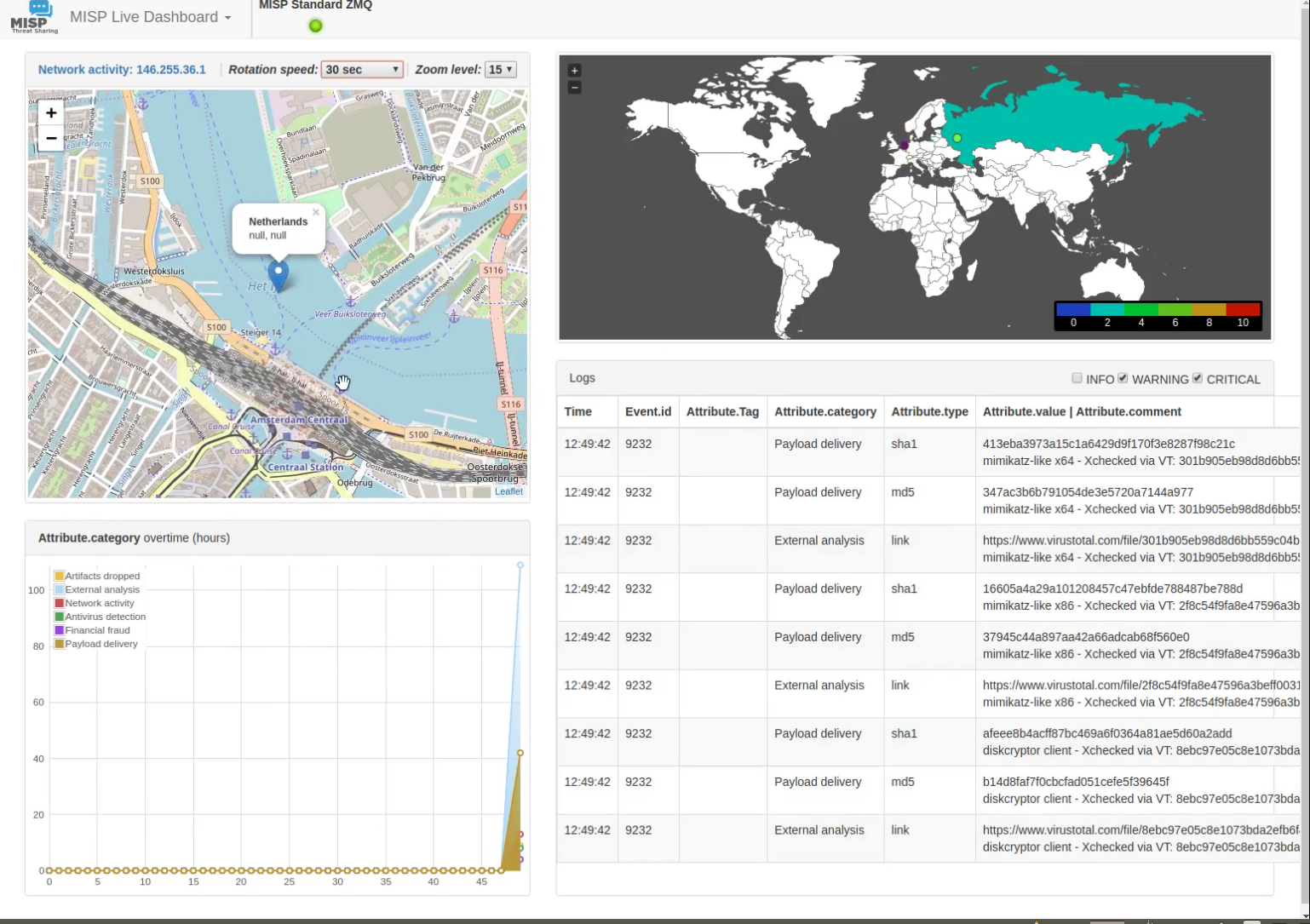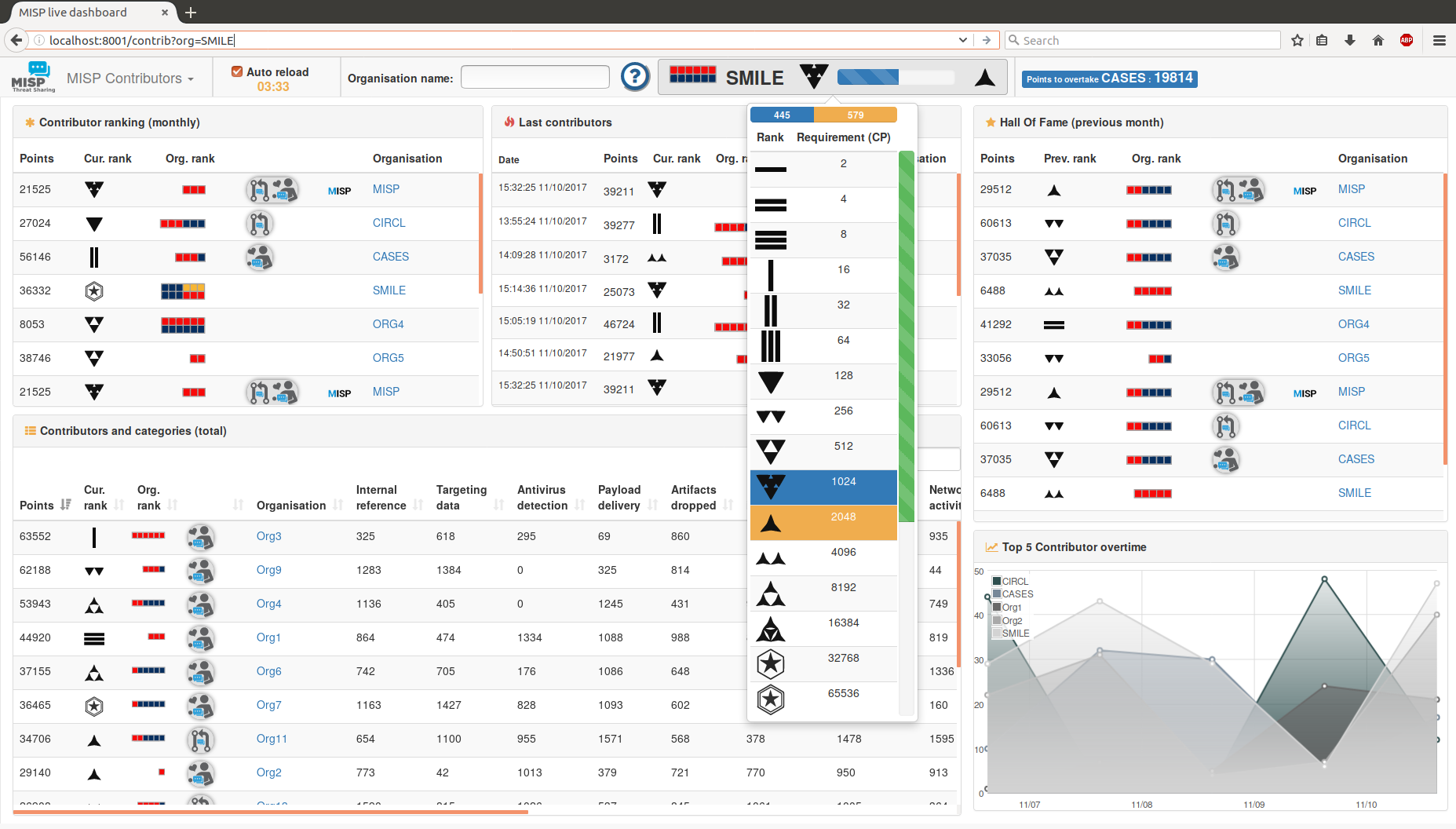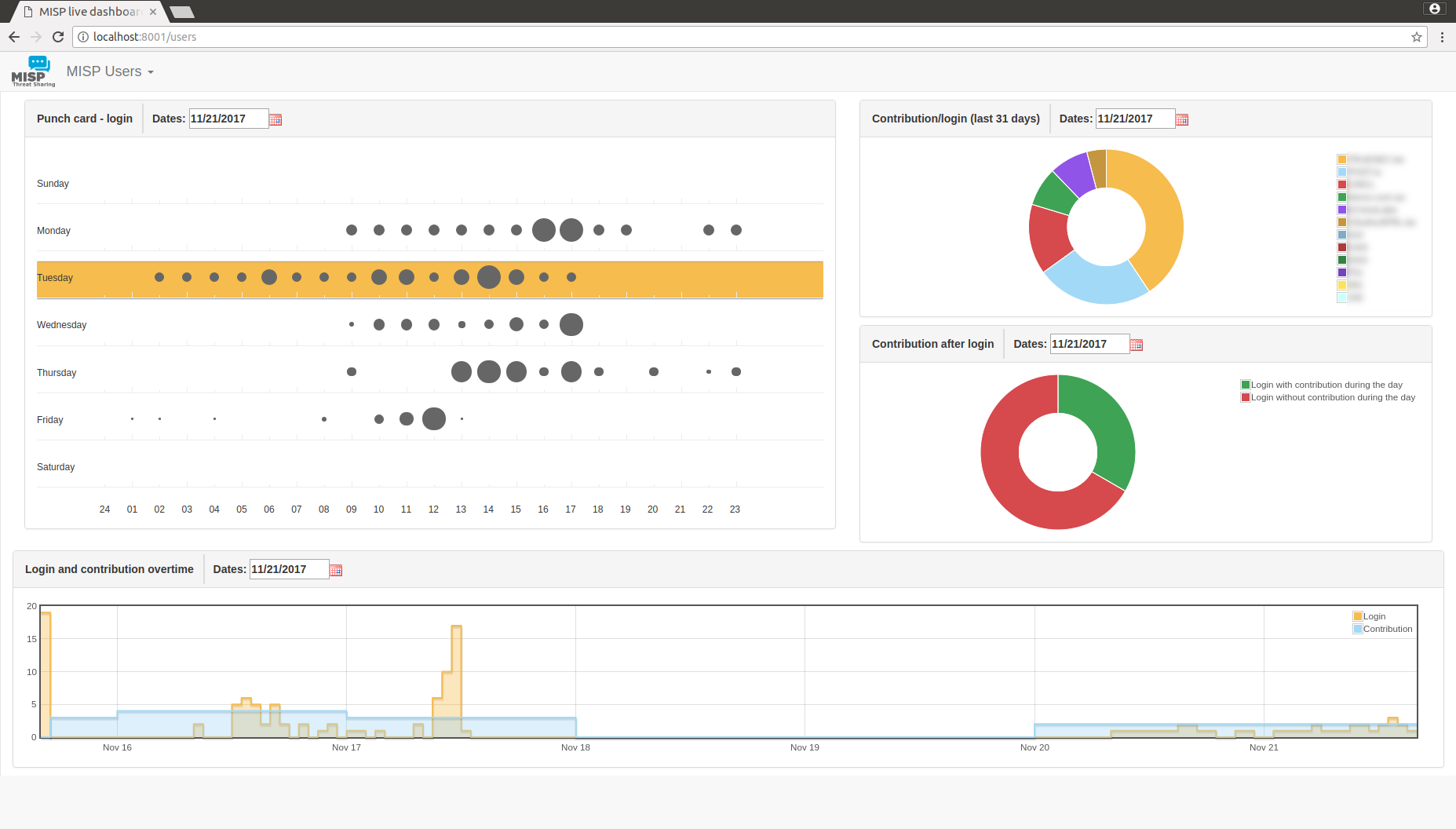|
|
||
|---|---|---|
| config | ||
| data | ||
| doc | ||
| helpers | ||
| screenshots | ||
| static | ||
| templates | ||
| tests | ||
| LICENSE | ||
| README.md | ||
| give_honors_to_org.py | ||
| install_dependencies.sh | ||
| misp-dashboard.wsgi | ||
| retreive_map_pic.py | ||
| server.py | ||
| start_all.sh | ||
| util.py | ||
| zmq_dispatcher.py | ||
| zmq_subscriber.py | ||
README.md
MISP-Dashboard
An experimental dashboard showing live data and statistics from the ZMQ of one or more MISP instances.
Installation
- Launch
./install_dependencies.shfrom the MISP-Dashboard directory - Update the configuration file
config.cfgso that it matches your system- Fields that you may change:
- RedisGlobal -> host
- RedisGlobal -> port
- RedisGlobal -> zmq_url
- RedisGlobal -> misp_web_url
- RedisMap -> pathMaxMindDB
- Fields that you may change:
Updating by pulling
- Re-launch
./install_dependencies.shto fetch new required dependencies - Re-update your configuration file
config.cfg
Starting the System
/!\ You do not need to run it as root. Normal privileges are fine.
- Be sure to have a running redis server
- e.g.
redis-server --port 6250
- e.g.
- Activate your virtualenv
. ./DASHENV/bin/activate - Listen to the MISP feed by starting the zmq_subscriber
./zmq_subscriber.py & - Start the dispatcher to process received messages
./zmq_dispatcher.py & - Start the Flask server
./server.py & - Access the interface at
http://localhost:8001/
Debug
Debug is fun and gives you more details on what is going on when things fail. Bare in mind running Flask in debug is NOT suitable for production, it will drop you to a Python shell if enabled, to do further digging.
Just before running ./server.py do:
export FLASK_DEBUG=1
export FLASK_APP=server.py
flask run --host=0.0.0.0 --port=8001 # <- Be careful here, this exposes it on ALL ip addresses. Ideally if run locally --host=127.0.0.1
OR, just toggle the debug flag in start_all.sh script.
Happy hacking ;)
Features
Live Dashboard
- Possibility to subscribe to multiple ZMQ feeds
- Shows direct contribution made by organisations
- Shows live resolvable posted locations
Geolocalisation Dashboard
- Provides historical geolocalised information to support security teams, CSIRTs or SOC finding threats in their constituency
- Possibility to get geospatial information from specific regions
Contributors Dashboard
Shows:
- The monthly rank of all organisation
- The last organisation that contributed (dynamic updates)
- The contribution level of all organisation
- Each category of contribution per organisation
- The current ranking of the selected organisation (dynamic updates)
Includes:
- Gamification of the platform:
- Two different levels of ranking with unique icons
- Exclusive obtainable badges for source code contributors and donator
Users Dashboard
- Shows when and how the platform is used:
- Login punchcard and overtime
- Contribution vs login
Trendings Dashboard
- Provides real time information to support security teams, CSIRTs or SOC showing current threats and activity
- Shows most active events, categories and tags
- Shows sightings and discussion overtime
zmq_subscriber options
A zmq subscriber. It subscribe to a ZMQ then redispatch it to the MISP-dashboard
optional arguments:
-h, --help show this help message and exit
-n ZMQNAME, --name ZMQNAME
The ZMQ feed name
-u ZMQURL, --url ZMQURL
The URL to connect to
Deploy in production using mod_wsgi
Install Apache's mod-wsgi for Python3
sudo apt-get install libapache2-mod-wsgi-py3
Caveat: If you already have mod-wsgi installed for Python2, it will be replaced!
The following packages will be REMOVED:
libapache2-mod-wsgi
The following NEW packages will be installed:
libapache2-mod-wsgi-py3
Configuration file /etc/apache2/sites-available/misp-dashboard.conf assumes that misp-dashboard is cloned into var/www/misp-dashboard. It runs as user misp in this example. Change the permissions to folder and files accordingly.
<VirtualHost *:8000>
ServerAdmin admin@misp.local
ServerName misp.local
DocumentRoot /var/www/misp-dashboard
WSGIDaemonProcess misp-dashboard \
user=misp group=misp \
python-home=/var/www/misp-dashboard/DASHENV \
processes=1 \
threads=15 \
maximum-requests=5000 \
listen-backlog=100 \
queue-timeout=45 \
socket-timeout=60 \
connect-timeout=15 \
request-timeout=60 \
inactivity-timeout=0 \
deadlock-timeout=60 \
graceful-timeout=15 \
eviction-timeout=0 \
shutdown-timeout=5 \
send-buffer-size=0 \
receive-buffer-size=0 \
header-buffer-size=0 \
response-buffer-size=0 \
server-metrics=Off
WSGIScriptAlias / /var/www/misp-dashboard/misp-dashboard.wsgi
<Directory /var/www/misp-dashboard>
WSGIProcessGroup misp-dashboard
WSGIApplicationGroup %{GLOBAL}
Require all granted
</Directory>
LogLevel info
ErrorLog /var/log/apache2/misp-dashboard.local_error.log
CustomLog /var/log/apache2/misp-dashboard.local_access.log combined
ServerSignature Off
</VirtualHost>
License
Images and logos are handmade for:
- rankingMISPOrg/
- rankingMISPMonthly/
- MISPHonorableIcons/
Note that:
- Part of
MISPHonorableIcons/1.svgcomes from octicons.github.com (CC0 - No Rights Reserved) - Part of
MISPHonorableIcons/2.svgcomes from Zeptozephyr (CC0 - No Rights Reserved)
Copyright (C) 2017 CIRCL - Computer Incident Response Center Luxembourg (c/o smile, security made in Lëtzebuerg, Groupement d'Intérêt Economique)
Copyright (c) 2017 Sami Mokaddem
This program is free software: you can redistribute it and/or modify
it under the terms of the GNU Affero General Public License as published by
the Free Software Foundation, either version 3 of the License, or
(at your option) any later version.
This program is distributed in the hope that it will be useful,
but WITHOUT ANY WARRANTY; without even the implied warranty of
MERCHANTABILITY or FITNESS FOR A PARTICULAR PURPOSE. See the
GNU Affero General Public License for more details.
You should have received a copy of the GNU Affero General Public License
along with this program. If not, see <http://www.gnu.org/licenses/>.





